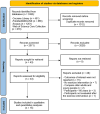Residual Effects of Physical Exercise After Periods of Training Cessation in Older Adults: A Systematic Review With Meta-Analysis and Meta-Regression
- PMID: 39764712
- PMCID: PMC11705206
- DOI: 10.1111/sms.70010
Residual Effects of Physical Exercise After Periods of Training Cessation in Older Adults: A Systematic Review With Meta-Analysis and Meta-Regression
Abstract
We aimed to determine the persisting effects of various exercise modalities and intensities on functional capacity after periods of training cessation in older adults. A comprehensive search was conducted across the Cochrane Library, PubMed/MEDLINE, Scopus, and Web of Science Core Collection up to March 2024 for randomized controlled trials examining residual effects of physical exercise on functional capacity in older adults ≥ 60 years. The analysis encompassed 15 studies and 21 intervention arms, involving 787 participants. The exercise and training cessation periods ranged from 8 to 43 weeks and 4 to 36 weeks, respectively. Meta-analyses were performed using change scores from before the physical exercise to after the training cessation. The effect sizes (ES) were calculated as the standardized mean differences between the intervention and control groups' change scores. Subgroup analyses and meta-regressions explored the influence of participant characteristics, the magnitude of the effect produced by the initial training program, various exercise modalities (resistance and multicomponent training) and intensities (high and low), and subdomains of functional capacity (agility, balance, standing ability, walking ability, and stair walking). The findings revealed that exercise interventions had a significant effect on preserving functional capacity after training cessation (ES = 0.87; p < 0.01). This protective effect was consistent across various exercise modalities and intensities (ES ≥ 0.67; p ≤ 0.04). The benefits obtained during the training program were positively associated with the residual effects observed after training cessation (β = 0.73; p < 0.01), while age negatively influenced the persisting adaptations (β = -0.07; p < 0.01). Current evidence suggests that exercise-based interventions, irrespective of modality and intensity, are highly effective in preventing functional declines after training cessation among older adults.
Keywords: deconditioning; functional impairments; long‐term effects; physical inactivity.
© 2025 The Author(s). Scandinavian Journal of Medicine & Science In Sports published by John Wiley & Sons Ltd.
Conflict of interest statement
The authors declare no conflicts of interest.
Figures
Similar articles
-
Exercise interventions on health-related quality of life for people with cancer during active treatment.Cochrane Database Syst Rev. 2012 Aug 15;2012(8):CD008465. doi: 10.1002/14651858.CD008465.pub2. Cochrane Database Syst Rev. 2012. PMID: 22895974 Free PMC article.
-
Falls prevention interventions for community-dwelling older adults: systematic review and meta-analysis of benefits, harms, and patient values and preferences.Syst Rev. 2024 Nov 26;13(1):289. doi: 10.1186/s13643-024-02681-3. Syst Rev. 2024. PMID: 39593159 Free PMC article.
-
Effects of Balance Training on Balance Performance in Healthy Older Adults: A Systematic Review and Meta-analysis.Sports Med. 2015 Dec;45(12):1721-38. doi: 10.1007/s40279-015-0375-y. Sports Med. 2015. PMID: 26325622 Free PMC article.
-
Dose-Response Relationships of Resistance Training in Healthy Old Adults: A Systematic Review and Meta-Analysis.Sports Med. 2015 Dec;45(12):1693-720. doi: 10.1007/s40279-015-0385-9. Sports Med. 2015. PMID: 26420238 Free PMC article.
-
Exercise for reducing fear of falling in older people living in the community.Cochrane Database Syst Rev. 2014 Nov 28;2014(11):CD009848. doi: 10.1002/14651858.CD009848.pub2. Cochrane Database Syst Rev. 2014. PMID: 25432016 Free PMC article.
References
Publication types
MeSH terms
Grants and funding
LinkOut - more resources
Full Text Sources
Medical


